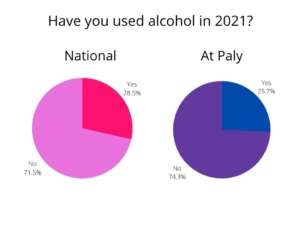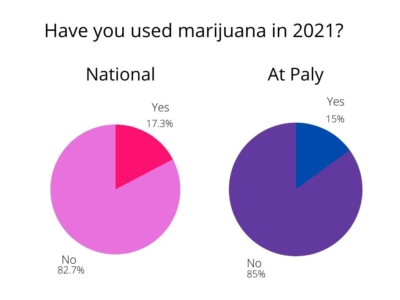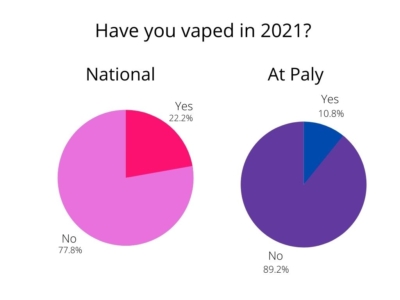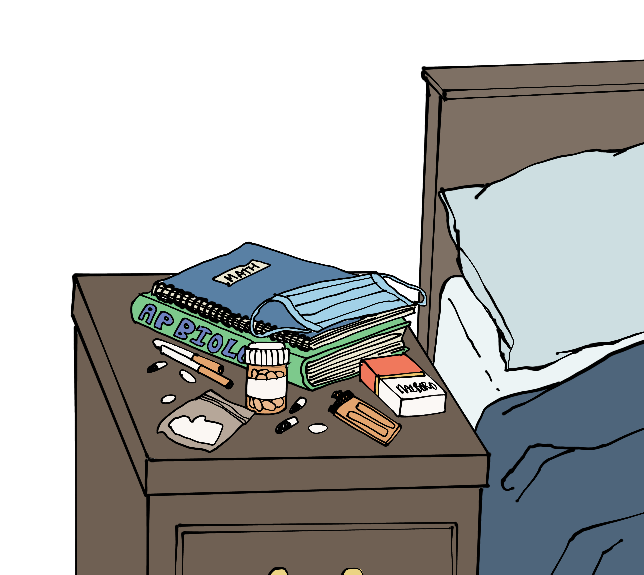Teens exhale e-cigarette smoke as they socialize. Red plastic cups dot the room. Music blares. This typical party scene in movies has been mostly absent from teen culture for the past two years. Following multiple restrictions on popular teen activities, nationwide teen drug use has fallen significantly— the largest decrease observed in five decades, according to the Monitoring the Future study by the University of Michigan, an ongoing research project that has studied American youth since 1975.

The percentage of 10th-graders that reported using alcohol, from 2020 to 2021, has fallen from 40.7% to 28.5%, a decrease of 12.2%. The percentage of 10th-graders who vaped in the past year has fallen by 12.4% as well, from 34.6% to 22.2%, the study says.


According to the hypothesis posed by the principal investigator of this study, Richard Miech, “Among the many disruptions adolescents have experienced as a result of the pandemic are disruptions in their ability to get drugs, disruptions in their ability to use drugs outside of parental supervision, and disruptions in peer groups that encourage drug use.”
Bonnie Halpern-Felsher, a developmental psychologist and professor of pediatrics at Stanford University, said that although drug use was already on the decline beforehand, it’s logical that the decrease continued during the pandemic.
“We know that a lot of drugs are a social product, so teens are using them to be able to socialize together,” Halper-Felsher said. “When you don’t have the ability to socialize as much, it makes sense that drug use is gonna go down.”
Drug use at Paly
While national trends reveal a decrease, teen drug use continues to be a prevalent problem, including at Palo Alto High School. Junior Katie Firtch said she has heard from several second-hand sources of drug use at Paly this year.
“I’ve heard that there have been drug exchanges in class,” Firtch said. “People have been exchanging things from backpack to backpack behind the teacher.”
Firtch said she believes there are two reasons why Paly students use drugs.
“The first reason is they think it makes them in the ‘in-crowd,’” Firtch said. “They think it makes them cool. The second is that they may feel pressured. They want to alleviate the pressure from school so they [turn] to chemical abuse.”
“Parents want to talk about these things, schools want to, but they don’t always know how.”
— Bonnie Halpern-Felsher, Stanford professor
Halpern-Felsher believes that teen misconceptions about drugs are especially harmful.
“The problem is that a lot of times teens think that using drugs helps them when the truth is what it’s really doing is hurting them more,” Halpern-Felsher said. “It’s kind of a false sense of pleasure, but it’s not really pleasure.”
Paly Wellness Center Mental Health and Wellness Coordinator Eva Martinez said avoiding drug use and peer pressure is dependent on a strong personal value system.
“It comes back to really being clear on your own motivation for not drinking or using drugs … [and] constant reminding yourself of what it is that’s driving your decisions,” Martinez said.
Popular culture
With a large presence in popular culture, drugs can appeal to teens through songs and hit TV shows like “Euphoria,” which shows teens using drugs frequently.
Halpern-Felsher said she is concerned about the widespread consumption of such media and how it portrays drug usage.
“I have a lot of concern about how drugs, particularly cigarettes, vaping, and marijuana are portrayed in the media, in movies [and] in music,” Halpern-Felsher said. “Young people listen and … look up to the celebrities who are using or promoting those products.”
Firtch said she believes popular culture does not paint the full picture of addiction.
“It glorifies it in a way, and although the media does sometimes show the more negative side of drug use, it’s often not associated with anything devastating and life-changing,” Firtch said. “We don’t see the inside part where they [drug addicts] struggle and they succumb.”
“There was a time where it was not cool to say no…. It is cool again to say no. And we need to emphasize that.”
— Bonnie Halpern-Felsher, Stanford professor
Legalization
Government legalization of marijuana for adults in some states, including California, has created additional effects on teen substance usage, with mixed results. Halpern-Felsher said that usage did not change much after legalization, but she also believes legalization may be sending an unintended dangerous message to teens that marijuana is safe.
“I think it’s more that the perceptions are changing,” Halpern-Felsher said. “Teens think it’s less harmful. Teens who were considering using it are maybe more likely to then go ahead and use it because they think that their feelings are validated.”
Improving the conversation
Halpern-Felsher said she believes much of the substance abuse issue stems from inadequate education and lack of conversation, and explained that many parents and educators do not know how to initiate conversations with teens on the topic.
“Sometimes they don’t have the education themselves to know how to talk about it,” Halpern-Felsher said. “So they feel uncomfortable … Parents want to talk about these things, schools want to, but they don’t always know how.”
Most of the education Paly students receive on drugs is in Living Skills, a required, semester-long course that sophomore Ashray Gupta said is beneficial to students. However, students can choose when to receive this education, and as a consequence, many delay it.
“Students usually take Living Skills as a senior, and in the three years before they take Living Skills, there’s not much education on that [drug use],” Gupta said.
Halpern-Felsher wants students to know that they should not feel embarrassed of using drugs and wanting to stop.
“It’s really important for young people to know that they’re not alone and that a lot of adults and peers are there to help them quit,” Halpern-Felsher said. “There was a time where it was not cool to say no…. It is cool again to say no. And we need to emphasize that.”



